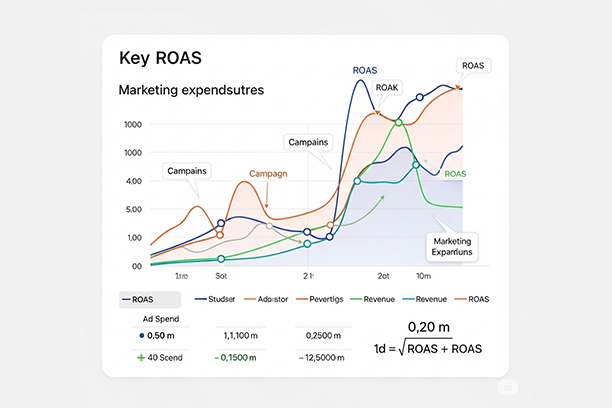Work Hours
Monday to Friday: 9AM - 6PM
Weekend: Closed

Running a successful pay-per-click (PPC) campaign isn’t just about getting clicks—it’s about getting results. Whether you’re promoting a product, service, or brand, paid advertising can drive measurable growth, provided you know what to measure. Without the right performance metrics, even the most visually appealing ads can drain your budget without delivering value.
In this guide, we’ll walk through the top 10 metrics every business should monitor to assess and improve the effectiveness of their PPC campaigns. These metrics can help you understand not just how your ads are performing, but how they’re contributing to your overall business goals.
1. Return on Ad Spend (ROAS)
ROAS is one of the most important performance indicators for any PPC campaign. It tells you how much revenue you earn for every dollar you spend on advertising.
Formula: ROAS = Revenue from Ads / Cost of Ads
A ROAS of 5:1 means you’re earning $5 for every $1 spent. The higher the ratio, the better your campaign is performing. However, what’s considered a “good” ROAS varies by industry, product pricing, and your overall margins.

How to Improve ROAS:
- Optimize ad targeting to focus on high-intent users
- A/B test your ad creatives and landing pages
- Use negative keywords to eliminate wasteful clicks
2. Click-Through Rate (CTR)
CTR is the percentage of people who click on your ad after seeing it. It’s a direct indicator of how appealing and relevant your ads are.
Formula: CTR = (Clicks / Impressions) × 100
A high CTR usually means your ad copy and targeting are effective. Low CTRs could indicate that your message isn’t resonating with your audience.
How to Improve CTR:
- Write compelling ad headlines and descriptions
- Include strong calls to action
- Use ad extensions to provide more context and value
3. Cost Per Click (CPC)
CPC shows how much you’re paying for each click on your ad. It’s essential for managing your budget and understanding the value of your traffic.
Formula: CPC = Total Ad Spend / Total Clicks
Lower CPCs are usually better, provided they still bring in qualified traffic that converts. However, ultra-low CPCs could sometimes signal poor ad quality or irrelevant traffic.
How to Reduce CPC:
- Improve your Quality Score
- Use more specific (long-tail) keywords
- Optimize your bidding strategy
4. Conversion Rate
Your conversion rate tells you what percentage of ad clicks result in a desired action—such as a purchase, form submission, or phone call.
Formula: Conversion Rate = (Conversions / Clicks) × 100
A strong conversion rate shows that not only are people clicking your ads, but they’re also finding value and taking the next step. It’s a key indicator of campaign efficiency.
How to Improve Conversion Rate:
- Simplify landing page forms
- Use persuasive CTAs and trust elements
- Ensure mobile responsiveness and fast loading speed
5. Cost Per Acquisition (CPA)
CPA, sometimes referred to as cost per conversion, tells you how much you’re spending to acquire a lead or customer. While similar to CPC, CPA focuses on actual results.
Formula: CPA = Total Spend / Total Conversions
High CPA can eat into profits quickly, especially if your average order value or client lifetime value is low. It’s crucial to aim for a sustainable CPA that matches your margins.
How to Lower CPA:
- Leverage audience targeting and remarketing
- Test ad creatives and landing pages
- Adjust device and demographic bids based on performance
6. Impression Share
Impression Share reflects how often your ad is shown compared to the total number of times it could have been shown (based on your targeting and budget).
Formula: Impression Share = (Impressions / Total Eligible Impressions) × 100
A low impression share can indicate that competitors are outbidding you or that your budget is too limited.
How to Improve Impression Share:
- Increase your budget for high-performing campaigns
- Improve ad quality to boost ad rank
- Focus on more specific, niche keyword groups
7. Quality Score
This is a Google Ads metric that evaluates your ad relevance, expected CTR, and landing page experience. It ranges from 1 to 10, with 10 being the highest.
Higher Quality Scores mean your ads are more relevant and user-friendly, which often leads to lower CPCs and better ad placements.
How to Increase Quality Score:
- Align keywords with ad copy and landing pages
- Focus on user experience and mobile responsiveness
- Continuously test and refine your ads
8. Bounce Rate
Bounce rate measures the percentage of users who land on your website and leave without taking any further action. In PPC, a high bounce rate often indicates a mismatch between ad copy and landing page content.
How to Reduce Bounce Rate:
- Ensure ad messaging matches landing page offers
- Speed up site loading times
- Remove unnecessary distractions on the page
9. Ad Relevance
Ad relevance measures how closely your ad matches the intent of the user’s search. It is a key component of the Quality Score and affects both CTR and CPC.
An ad with poor relevance is unlikely to perform well, regardless of your budget.
How to Improve Ad Relevance:
- Group keywords into tight ad groups
- Write highly specific ad copy for each ad group
- Tailor landing pages to match ad intent
10. Click Conversion Lag
Click conversion lag refers to the amount of time it takes a user to convert after clicking on an ad. This is especially important for services with longer sales cycles.
Understanding this lag helps you more accurately attribute results and budget accordingly.
How to Manage Click Conversion Lag:
- Analyze attribution models to better reflect user behavior
- Implement retargeting for users who don’t convert immediately
- Use CRM tools to track long-term conversion journeys
Bonus Tip: Use Integrated Reporting Tools
To monitor all these metrics effectively, take advantage of platforms like Google Ads, Google Analytics, and third-party tools such as Semrush or HubSpot. Ensure that your conversion tracking is properly set up and test frequently to make data-driven decisions.
Conclusion
Measuring PPC success goes far beyond looking at clicks and impressions. By tracking the right metrics, like ROAS, CTR, Conversion Rate, and Quality Score, you can gain deep insights into your campaigns and take actionable steps to improve them.
Whether you’re running ads on Google, Facebook, or another platform, using these metrics as a foundation helps ensure that every dollar spent is bringing you closer to your business goals.
Ready to maximize your PPC performance?
Contact us today for a free audit and discover how we can help you lower costs and increase ROI.

